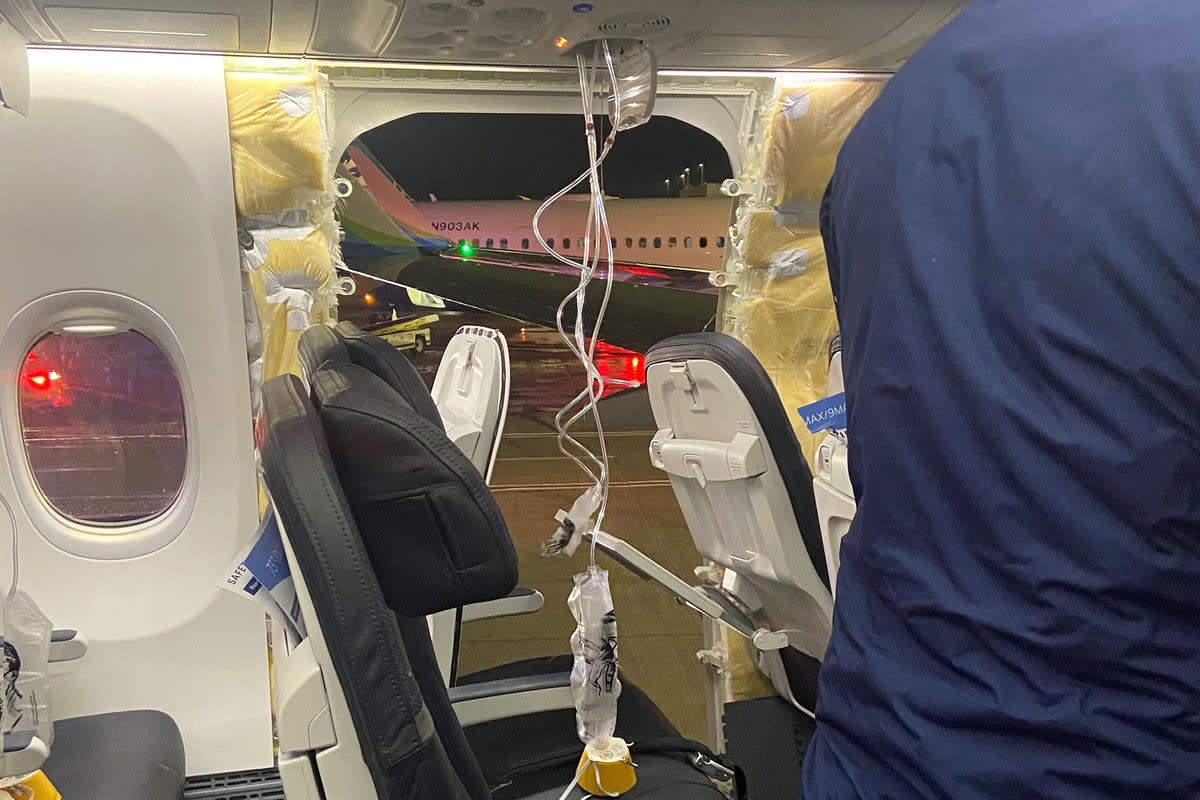Alaska Airlines grounds all Boeing 737 Max aircraft after plane blowout

Alaska Airlines has grounded dozens of Boeing 737 MAX 9 jets for safety checks after a mid-air cabin panel blowout forced an aeroplane full of passengers to make an emergency landing.
Flight 1282 to Ontario, California experienced major depressurisation during the terrifying incident at 16,000ft on Friday evening. Posts uploaded to social media show a window and a portion of the side of the plane missing and oxygen masks deployed.
Dramatic accounts from eyewitnesses described a child sat nearest to the window breach who had to be held down in their seat as loose items like mobile phones flew out of the plane due to the sudden loss of pressure.

Photos shared on the image-sharing website Imgur also show that the rear mid-cabin exit door separated from the aircraft during the flight.
All 177 passengers and crew were safe when the aircraft landed back in Portland. But the incident has once again raised questions about an aircraft type that was involved in two fatal crashes.
There were no immediate indications of the cause of the apparent structural failure nor any reports of injuries.
Airline CEO Ben Minicucci said in a statement its fleet of 65 similar planes would be returned to service only after precautionary maintenance and safety inspections, which he expected to be completed in the “next few days”. US aviation authorities have also announced an investigation.
The Boeing 737, first launched in 1967, is the world’s most successful aircraft – with around 10,000 delivered. But the latest version, the Max, was involved in two tragedies.
On 29 October 2018, a faulty sensor triggered an anti-stall system that caused Lion Air flight 610 to crash shortly after take-off from Jakarta. All 189 passengers and crew died.

Less than six months later, Ethiopian Airlines flight 302 from Addis Ababa to Nairobi was lost, along with 157 lives, in similar circumstances.
The plane was grounded worldwide shortly afterwards. After a rigorous redesign and certification, the aircraft is flying again – including for Europe’s biggest budget airline, Ryanair.
The National Transportation Safety Board said on Saturday that a team of experts in structures, operations and systems would arrive on the scene in Portland later that day.
Boeing also said it was looking into the incident.
“We are working to gather more information and are in contact with our airline customer,” Boeing said.
Flight 1282 had reached just over 16,000ft when the blowout happened, according to FlightRadar24.

“We’d like to get down,” the pilot told air traffic control, according to a recording posted on liveatc.net.
“We are declaring an emergency. We do need to come down to 10,000,” the pilot added, referring to the initial staging altitude for such emergencies, below which breathing is considered possible for healthy people without extra oxygen.
Social media posts showed oxygen masks deployed and a portion of the aircraft’s side wall missing.
Passenger photos appeared to show that a section of the fuselage sometimes used for an optional rear mid-cabin exit door had been torn away, leaving a door-shaped gap.
The extra door is typically installed by low-cost airlines using extra seats that require more paths for evacuation.
However, those doors are permanently “plugged”, or deactivated, on Alaska Airlines jets.
The new MAX 9 was delivered to Alaska Airlines in late October and certified in early November, according to FAA data.
“Whenever you have a rapid decompression such as this, it’s a major safety event,” said Anthony Brickhouse, an air safety expert at Embry-Riddle Aeronautical University.
“I can’t imagine what these passengers experienced. It would have been loud. The wind would be rushing through that cabin. It was a probably pretty violent situation, and definitely a scary situation.”

The incident shows the importance of passengers keeping their seatbelts buckled while seated in an airplane, even if the fasten seatbelt light is off, Brickhouse said, noting that the oxygen mask system appeared to have functioned properly.
Reports said the seat next to the left-hand panel, which contains an ordinary passenger window, was unoccupied.
“This is a very, very serious situation and it could have been a lot worse,” he said. “If someone had been sitting in that seat, and they weren’t buckled in, it would have been a different situation.”
China’s aviation regulator is conducting an emergency meeting to consider a response to the incident, including a possible new grounding of the Boeing MAX fleet in the country, Bloomberg reported on Saturday.
China was the first country to ground the MAX in 2019 and only recently started accepting new deliveries, though domestic services using the plane resumed in January last year.
Last week, Boeing said it was urging airlines to inspect all 737 MAX aeroplanes for a possible loose bolt in the rudder control system.
The FAA said it was closely monitoring Boeing 737 MAX inspections and would consider additional action if more loose or missing hardware was found.
The fuselage for Boeing 737 planes, its most popular model, is made by Kansas-based Spirit AeroSystems, which separated from Boeing in 2005.
In August, Boeing identified a quality problem involving Spirit that resulted in improperly drilled holes on the aft pressure bulkhead.
It was not immediately clear whether the door “plug” used to replace the door when not selected by airlines is also made by the Wichita, Kansas-based, supplier, nor whether the Alaska incident was related to factory processes or design.
A spokesperson for Boeing said: “We are working to gather more information and are in contact with our airline customer. A Boeing technical team stands ready to support the investigation.”

 Yahoo News
Yahoo News 
